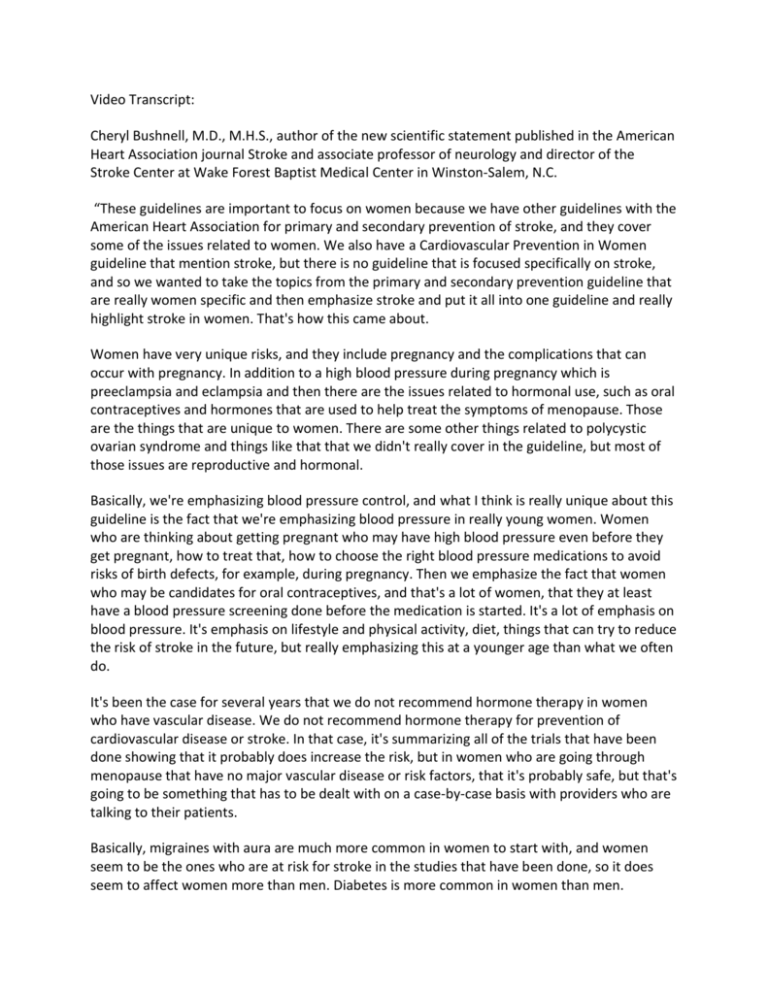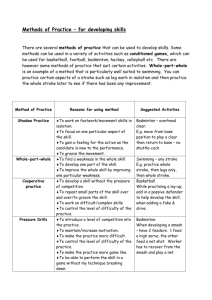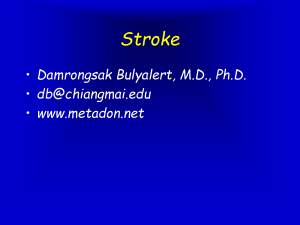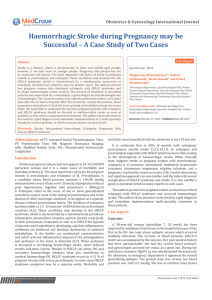Video Transcript: Cheryl Bushnell, M.D., M.H.S., author of the new
advertisement

Video Transcript: Cheryl Bushnell, M.D., M.H.S., author of the new scientific statement published in the American Heart Association journal Stroke and associate professor of neurology and director of the Stroke Center at Wake Forest Baptist Medical Center in Winston-Salem, N.C. “These guidelines are important to focus on women because we have other guidelines with the American Heart Association for primary and secondary prevention of stroke, and they cover some of the issues related to women. We also have a Cardiovascular Prevention in Women guideline that mention stroke, but there is no guideline that is focused specifically on stroke, and so we wanted to take the topics from the primary and secondary prevention guideline that are really women specific and then emphasize stroke and put it all into one guideline and really highlight stroke in women. That's how this came about. Women have very unique risks, and they include pregnancy and the complications that can occur with pregnancy. In addition to a high blood pressure during pregnancy which is preeclampsia and eclampsia and then there are the issues related to hormonal use, such as oral contraceptives and hormones that are used to help treat the symptoms of menopause. Those are the things that are unique to women. There are some other things related to polycystic ovarian syndrome and things like that that we didn't really cover in the guideline, but most of those issues are reproductive and hormonal. Basically, we're emphasizing blood pressure control, and what I think is really unique about this guideline is the fact that we're emphasizing blood pressure in really young women. Women who are thinking about getting pregnant who may have high blood pressure even before they get pregnant, how to treat that, how to choose the right blood pressure medications to avoid risks of birth defects, for example, during pregnancy. Then we emphasize the fact that women who may be candidates for oral contraceptives, and that's a lot of women, that they at least have a blood pressure screening done before the medication is started. It's a lot of emphasis on blood pressure. It's emphasis on lifestyle and physical activity, diet, things that can try to reduce the risk of stroke in the future, but really emphasizing this at a younger age than what we often do. It's been the case for several years that we do not recommend hormone therapy in women who have vascular disease. We do not recommend hormone therapy for prevention of cardiovascular disease or stroke. In that case, it's summarizing all of the trials that have been done showing that it probably does increase the risk, but in women who are going through menopause that have no major vascular disease or risk factors, that it's probably safe, but that's going to be something that has to be dealt with on a case-by-case basis with providers who are talking to their patients. Basically, migraines with aura are much more common in women to start with, and women seem to be the ones who are at risk for stroke in the studies that have been done, so it does seem to affect women more than men. Diabetes is more common in women than men. Psychosocial stress and depression are more common in women and have been associated with the risk of stroke and heart disease. Atrial fibrillation is more common in women, and women are more likely to develop the clotting, example stroke, with the atrial fibrillation and require more rigorous treatment. The other thing about atrial fibrillation is that women live longer, and atrial fibrillation is a disease of the aging. The risk factors or the signs of a stroke are the same for men and women. Women may have more vague complaints than men. They may have more pain, they may have altered consciousness, but regardless, the weakness on one side, the numbness, tingling on one side, the difficulty with speech, coordination, balance; those are the same in women and men. The main thing that women should know is that they should be screened for a history of pregnancy complication such as preeclampsia as part of their risk factor assessment. Preeclampsia increases the risk of stroke twofold, and it increases the risk of developing hypertension by fourfold, so those are two, and it's probably independent even of hypertension. Preeclampsia is something that most providers should really document in the medical record right up there with diabetes and high blood pressure and cholesterol and smoking, and so it just needs to be recognized as a risk factor and in fact it should really prompt the providers to talk about lifestyle changes and things that women, even young women can do to try to prevent the risk of stroke in the future. We have a sedentary society unfortunately, and so increasing exercise and eating right, and the American Heart Association has the whole Life's Simple 7 and that's what I would emphasize for younger women and all women who may be at risk for stroke, and we're trying to improve the general health of the population here. All of those actions will help prevent stroke in the future, especially for women.” copyright American Heart Association










